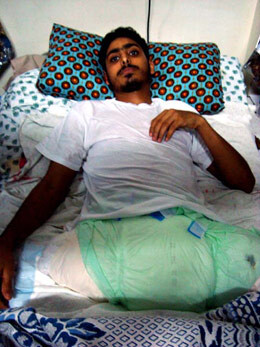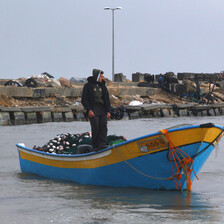The Electronic Intifada 22 December 2008

Journalist and student Hamzi Shaheen lies in his hospital bed in Gaza City after losing both of his legs in an Israeli air strike. (Eva Bartlett)
The ground-to-ground missile fired from the Israeli side of Gaza’s eastern border injured an additional three residents, including Oukal’s son Ahmed, seven years old, who suffered rocket shrapnel wounds to his hand and head. Israeli authorities claimed that the missile was a response to rockets being fired from the area. However, Oukal’s family and neighbors report all had been quiet.
“He wasn’t one of the resistance fighters,” his teenage daughter explained. “And there weren’t any rockets being fired before he was hit. It was quiet, and the shelling was sudden,” she said.
On 7 December, a legal adviser to Israel’s ministry of defense, Ahaz Benari, told Defense Minister Ehud Barak that “Artillery fire is permissible only in relatively open areas,” adding that “artillery fire at urban areas is problematic, if the assessment is that the chance that the shell will hit the launchers is relatively low, while the risk that many civilians will be hurt is substantial.”
“His arm landed here in front of our window,” said Oukal’s neighbor, Abu Ashraf Salha. “He initially ricocheted off the house upon impact of the missile,” he explained further, detailing how parts of Oukal’s severed body flew in various directions. His house, along with Oukal’s and another neighbor, sustained significant damage from the missile’s impact just meters away. “It shattered our roof,” Salha explained, pointing to the pieces of asbestos tile littering the living room floor. “Everything in here was damaged, the furniture, the TV, the lights.”
Salha’s sister was sitting in the living room when the light fixture fell down, but escaped injury. He added that “Three of my kids were lying [in the bedroom] when the roof caved in. Thank God they were not seriously hurt.”
Two boys
Sari al-Sanana, eight years old, and his friend Safi, nine years old, lie gravely wounded in the intensive care unit at Gaza City’s al-Shifa hospital. Their life-threatening injuries came amid the days of rocket attacks around northern Gaza. On 20 December at 2:45pm, the two friends were bicycling in a area near Beit Hanoun, not far from the Israeli border. An Israeli missile landed between the youths, throwing them from their bikes and riddling their bodies with shrapnel. Both boys sustained head trauma. According to witnesses in the area, no rockets were fired by Palestinian resistance groups before the boys were hit.
“As you see, he is a child, a victim, not a fighter. About 30 percent of our cases are children like him,” explained Dr. Fawzi Nablusi, one of al-Shifa’s hospital emergency room doctors. Safi was still in surgery at the time of this report and Sari remained unconscious, his tiny frame battered, the only movement on his listless body was a trickle of fresh blood running from his nose and mouth. The doctor could only estimate that the boys’ chances of surviving without severe complications were slim. “They are in critical condition, surviving on medical [equipment] and with potentially fatal brain hemorrhaging,” he updated the following day.
Two reporters
On 16 December, Mohammad Abd al-Nadi, a journalist for al-Quds Radio, was hit by a missile fired from an unmanned drone as he walked along Salah al-Din Street. He was looking for a taxi in order to cover earlier shelling from a United States-manufactured Apache helicopter, in the Beit Hanoun area in which two women were attacked. The drone’s missile left him with a fractured arm, a head injury, and cuts over his body and leg.
“It’s the second time I’ve been targeted,” he explained from his al-Shifa hospital bed. “Two years ago I was also shelled by a drone, but luckily I wasn’t seriously injured.”
Hamzi Shaheen, 21 years old, was hit in an earlier strike on 7 December. It was 3:30pm and the journalist and student at Gaza City’s al-Azhar University was working on his family farm in Jabaliya. He was also hit by a missile fired from an unmanned drone. Four years ago, Shaheen’s 20-year-old brother was struck and killed by a drone-fired missile while at a summer camp in Jabaliya. His father was killed in 1987 and Shaheen still lives at home, helping his mother with daily chores. Two weeks after the attack, he lies recovering in al-Shifa hospital, his stubs of legs bandaged but he remains resilient. “I will continue my studies, when I’m well enough,” Shaheen pledged.
The farmer
Zuhair Washa, 48 years old, is the father of nine children, including three currently enrolled in university. On 20 December at 7:30 am, Washa was working on his land in the al-Shejaeya neighborhood east of Gaza City, a considerable distance from the Israeli border, when an Israeli ground-to-ground missile exploded near him, shattering the bones in the lower half of his right leg. The fractured leg and remaining nerve damage as well as the wounds to his hands and body, mean that he will be unable to work and support his family for some time.
These victims were all targeted in rural and residential civilian areas where witnesses reported no resistance activity before or during the time of each attack. International law condemns the deliberate targeting of civilians as a gross violation of human rights, amounting to a war crime. Sadly, Palestinian civilians in Jabaliya, Beit Hanoun, al-Shejaeya, and across Gaza are all too familiar with these crimes of war, perpetrated with impunity.
Eva Bartlett is a Canadian human rights advocate and freelancer who spent eight months in 2007 living in West Bank communities and four months in Cairo and at the Rafah crossing. She is currently based in Gaza, after the third successful voyage of the Free Gaza Movement to break the siege on Gaza.
Related Links




